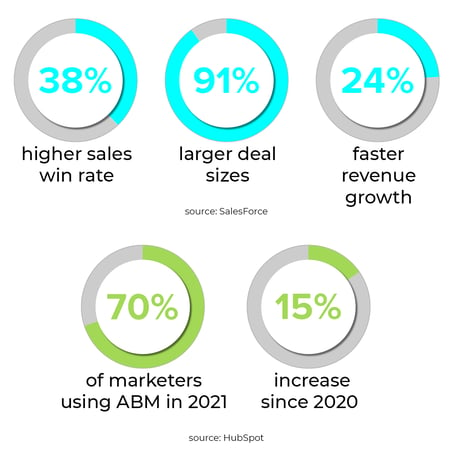Account Based Marketing: The Strategy Synonymous with Higher B2B ROI
0 min read
Account-based marketing is the one-to-one, deeply personalized answer to inbound marketing’s dilemmas.
No more mass campaigns to unqualified or incompatible leads…
No more misalignment between sales and marketing teams…
No more lost leads because of bumpy handoffs or mixed messages…
No more clawing your way to a return on investment with low-value accounts...
And hello, account-based marketing.
Pursuing handselected, high ROI accounts account-based marketing—or ABM—is the modern star of the marketing world for good reason.
Salesforce rounds up key stats supporting ABM’s positive attention:
“B2B companies with ABM programs report a 38% higher sales win rate and 91% larger deal sizes, leading to 24% faster revenue growth.”

It’s no wonder B2B, enterprise, and SaaS companies are widening their eyes at the prospect of embracing account-based marketing themselves. According to Hubspot, 70% of marketers reported using ABM in 2021, up 15% from 2020. Here’s why.
Let’s define account-based marketing.
Who invented account-based marketing & when did account-based marketing start?
The creation of the term “account-based marketing” is credited to ITSMA in 2004, though the concept has been used in one form or another since the 1980s. Technology improvements sped up our ability as marketers to collect and assess customer journey data, enabling ABM as we know it today.
You might be familiar with account-based sales, which follows similar principles—chiefly treating individual accounts as “target markets” in their own rights.
How does account-based marketing work?
Account-based marketing changes what we know about acquiring new customers. Interestingly, it flips the traditional “inverted triangle” concept we’re taught when it comes to campaign planning.
While inbound marketing focuses on lead volume, ABM is dedicated to lead quality. So instead of casting a broad net to particular industries or job titles when creating your marketing strategy, ABM starts with targeting specific clients.
The vital question in an ABM strategy is: “Who do you want to win over?”
Finding and identifying your client avatar is central to mounting your ABM campaign. A thorough profile of your ideal customer is #1 on our list of must-haves for ABM strategies, and it’s the guiding light that keeps your entire approach on track.
Once you’ve outlined a profile, you can find accounts that match it, build your contact list, reach out with highly personalized pitches, and create content that directly serves those targets.
The result is a more one-to-one, customized solution for your customer and impressive results for you.
Why is account-based marketing important?
ABM is the epitome of working smarter, not harder.
The difference? Focus.
Disparate systems, approaches, and strategies across sales and marketing teams have caused headaches for enterprise and B2B businesses since the dawn of time. With ABM, consistency is essential to helping everyone win—internally and client-side.
Establishing a concentrated ABM plan reaps ongoing benefits for everyone involved:
- Higher ROI on marketing efforts: The biggest draw is the idea of targeting high-value accounts directly, rather than hoping to catch a few big fish when you cast a broad net. Get more bang for your marketing buck with this strategic approach.
- Stronger client relationships: ABM puts your target clients at the heart of your marketing, as if everything you’re doing were made especially for them. Establish clear synergy early on to show every account that you deeply care about keeping them happy.
- A shorter sales cycle: According to Spotio, an average of seven decision makers are involved in the B2B buying process. You start your ABM campaigns in the know, understanding who the key players are within an organization, what they are looking for, and the pain points people in their roles face. You know who many—if not all—the decision-makers at your target companies are, so you can bring them into the conversation earlier, address their objections sooner, and close deals faster.
- Smarter resource allocation: 67% of lost sales are a result of sales reps not properly qualifying potential customers before taking them through the full sales process. Between your human resources, time, and tools, you have a lot to lose when deals slip away. ABM aligns your sales and marketing teams through a cohesive vision, a joint effort to identify target accounts, and content creation that facilitates conversions for those agreed-upon demographics. So, there are fewer stop gaps and missed messages that hinder customer acquisition or satisfaction. Plus, those unified teams will be focused on high-potential prospects instead of a large pool of unlikely converts.
With your teams working in tandem and your resources freed up to focus on ROI-friendly deals, you’re capable of securing more accounts.
How to get started with account-based marketing
1. Collaborate with an agency that specializes in ABM
Our top advice is to work with a team that already knows the ropes. As you start with ABM, you are not only figuring out how it works, but also how to make it work for you. The transition can be taxing for sales and marketing teams alike, as the changeover to ABM requires a mindset shift in addition to system reconfiguration.
Instead of trying to navigate the unknown alone, consider working with an experienced ABM agency that has helped other enterprise businesses successfully get this approach off the ground. Their insights about best practices will allow you to avoid costly mistakes of trial and error, and ramp you up for the favorable results of a working ABM strategy faster.

Choose a high-impact agency for your account-based marketing
Digital Reach works tirelessly every day to propel B2B, enterprise, and SaaS businesses of all sizes toward positive ABM outcomes. From consumer research and ideal customer profile creation to marketing automation and CRM integrations, we know the ins and outs of planning, launching, and optimizing for your success.
2. Take a look at your current and historical data
ABM requires an understanding of your highest-value clients and projections about who your highest-value prospects will be. Your data contains the answers.
Consult historical data—including proposals, revenue, time logs, and other available metrics—to determine who your heaviest hitters have been in the past. In addition to combing through your objective data, circle the wagons and unify your teams: talk to sales, marketing, and management teams to discuss observational data about the clients you’ve worked with. This will aid you in developing ideal customer profiles that reflect your high-impact accounts—a key component of a strong ABM approach.
 3. Secure ABM-enabling tools for your teams
3. Secure ABM-enabling tools for your teams
Is your CRM capable of supporting an ABM strategy?
According to LinkedIn’s Global State of Sales Report, a whopping 76% of salespeople label their sales technology as “critical or extremely critical to closing deals,” and we couldn’t agree more.
Not only do you need to get your teams on board to collaborate in new ways, but the systems you use will need a facelift, too. Account-level targeting and built-in personalization features are going to be a must for a smooth transition, and your CRM may miss the mark if it only manually tracks conversations with leads.
However, depending on what you’re already using, your existing toolkit might pivot with you. There are plenty of tools offered by HubSpot for ABM, for example, which top our list of recommendations, allowing you to:
- Define ideal customer profiles with workflow templates and create automation based on those parameters.
- Facilitate clear communication between teams with a birds-eye view of all major accounts and integrations with Slack.
- Personalize content to strengthen your outreach and increase engagement.
- Integrate with LinkedIn Ads to directly target companies based on status or tier, or focus on specific people within an organization.
- Understand your successes with thorough tracking throughout your ABM campaign.
Hubspot is a comprehensive platform designed to unify your sales, marketing, and service teams, making it the ideal frictionless tool for your foray into ABM. This strategy hinges on the smooth transition of high-value accounts through the sales pipeline, into onboarding, and onto being delighted by your business.
Creating effortless experiences for your target accounts is crucial to maintaining their business and securing referrals for equally valuable accounts. Don’t underestimate the power of the platforms you use!
Ready to make the move to Account-Based Marketing?
As Platinum HubSpot partners, we often sing the praises of HubSpot’s many sales, marketing, and service tools. We highly recommend a HubSpot migration to lay the groundwork for renovating your marketing strategy to lean on account-based marketing.
Tap into their extensive ABM tools and start seeing the remarkable results so many other B2B, enterprise, and SaaS companies are raving about.





